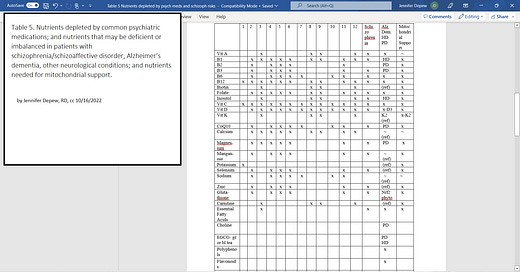Disturbingly transparent Table.
What do Nutrients depleted by psych drugs, risk factors for schizophrenia and Alzheimer's, Huntington's, Parkinson's, and Mitochondrial Support nutrients all have in common? Probably essentialness.
I forgot to update the title, darn. Table 5. Nutrients depleted by common psychiatric medications and nutrients that may be deficient or imbalanced in patients with schizophrenia/schizoaffective disorder and mitochondrial support nutrients - all overlap. View: https://www.dropbox.com/s/qpdufs1rpfzyf9a/Table%205%20Nutrients%20depleted%20by%20Psych%20meds.docx?dl=0
The draft with a few small additions and the updated Table 5 linked is on my transcendingsquare.com site.
Medication data from; Antidepressants, Antipsychotics and Stimulants, Dr. David W. Tanton, Ph.D. (Tanton, 2006) Schizophrenia factors is a separate reference list (to be organized yet). See below Table for Alzheimer’s and Mitochondrial Support references in addition to (Madireddy, Madireddy, 2019).
The psychiatric drugs: 1. Adderall, 2. Celexa, 3. Depakote, 4. Effexor, 5. Paxil, 6. Prozac, 7. Remeron, 8. Risperdal, 9. Seroquel, 10. Welbutrin/Zyban, 11. Zoloft, 12. Zyprexa.
Celexa, Effexor, Paxil, Prozac and Zoloft (2, 4, 5, 6, 11) all have similar nutrient depletions. Depakote, Risperdal, Seroquel and Zyprexa (3, 8, 9, 12) also all have similar nutrient depletions. Remeron and Welbutrin/Zyban (7, 10) are also similar, and fewer. Adderall (1) has the fewest nutrients at risk of depletion of the group.
Alzheimer’s dementia, HD, PD.
Alzheimer’s dementia (AD), Huntington’s (HD) and Parkinson’s disease (PD), nutrients of concern, an ‘x’ is when it is for AD or in general. Additionally found helpful: flavonoids, isoflavones, anthocyanins, and “polyphenols such as catechins, anthocyanins, resveratrol, theaflavins and curcumin.” (Madireddy, Madireddy, 2019).
Nutrients not mentioned by Madireddy and Madireddy have (ref) instead of an x. Manganese in excess is causal of AD and PD and is seen in long-term TPN patients, it causes amyloid over-production. (Martins, et al, 2019) (Lin , et al, 2020) Selenium is beneficial in AD. (Hertzog da Silva Leme and Cardoso, 2020) Potassium adequacy is helpful for AD, (Cisternas, et al, 2015), however there can be low potassium in the brain while there is adequacy in the cerebrospinal fluid suggesting mitochondrial dysfunction, (Roberts, et al, 2016), and disrupted potassium channel activity due to amyloid beta protein. (Taylor, 2022) Vitamin K2 may be beneficial but has not had clinical trials for AD. (Popescu and German, 2021) High dose biotin may be beneficial. (Lohr, et al, 2020) (McCarty and DiNicolantonio, 2017) Calcium is in excess intracellularly. Cannabinoid adequacy is protective. “The ryanodine receptor (RyR) is a channel that exist in the endoplasmic reticulum (ER), previous studies have shown that cannabinoid-based therapies can modulate RyRs, reverse AD-related pathological changes, and mitigate cognitive deficits.7” (Ge, et al, 2022) Sodium in excess is causal in animal studies, while clinical trials with reduced sodium diets have had mixed results. Mediterranean and DASH diets have shown benefit though. (Mohan, et al, 2020) *Dietitian input – do a study that looks at the ratio of potassium to sodium in the diet, not just total sodium. It is the ratio that counts too – low potassium and high sodium intake is the worse risk for cardiovascular health. Zinc – low levels are associated with AD and worse progression of the condition. Low zinc levels increase amyloid accumulation. (Kim, et al, 2021) N-acetyl-carnitine was beneficial for slowing progression in a clinical trial. (Spagnoli, et al, 1991)
Mitochondrial Support
~ Vitamin A is needed by mitochondria, (Chiu, et al, 2008), while excess activated retinoids are harmful to mitochondria. (de Oliveira, 2015) Hyponatremia or low calcium (Killilea and Killilea, 2022) or excess sodium (Mehrer, et al, 2022) or excess calcium (Pivovarova and Andrews, 2010) would cause mitochondrial dysfunction.
The Citric Acid Cycle requires these nutrients, free amino acids and cofactors:
B vitamins: B1 (Thiamin) (3) , B2 (Riboflavin) (4), B3 (Niacin) (8, 10), B5 (Pantothenic acid) (5), B6 (Pyridoxine) (6, 7), B7 (Biotin), B9 (Folate) (9),
Minerals (17): Mg++ (Magnesium) (11, 12, 13), Mn++ (Manganese), K+ (Potassium) (13), Zinc (14, 15), Iron (16), Copper, Sulfate,
Amino acids: Carnitine (derived from lysine), Cysteine,
Antioxidants: CoQ10, Glutathione, Alpha-Lipoic Acid (ALA).
From a graphic labeled by Dmitry Kats, PhD. Additional links at: https://transcendingsquare.com/2021/04/30/niacin-may-help-reduce-chronic-migraines/
B12 has a coenzyme role in mitochondria. (Janssen, et al, 2019) Inositol is an inhibitor of AMPK and therefore is protective against mitochondrial fission. (Hsu, et al, 2021) The Vitamin D Receptor has a regulatory role over mitochondrial function. (Ricca, et al, 2018) Vitamin C is protective of mitochondria as an additional antioxidant, excess could be a pro-oxidant against cancer cells. (Singh and Vir, 2010) Vitamin K2 has a protective and regulatory role over mitochondria apoptosis and biogenesis. (Tang, et al, 2022) Essential fatty acids are essential for mitochondrial membranes. (Sullivan, et al, 2018) Selenium is protective of mitochondria and promotes biogenesis of mitochondria. (Mehta, et al, 2012)
Do glass houses have glass tables?
Disclaimer: This information is provided for educational purposes within the guidelines of Fair Use. It is not intended to provide individual guidance. Please seek a health care provider for individualized health care guidance.







Very informative easy to understand chart. Thank you!
I am very curious about Alzheimer’s dementia as my stepmother and her mother both had this. I am not buying the genetic line as a total answer, especially after seeing your post. Thanks!